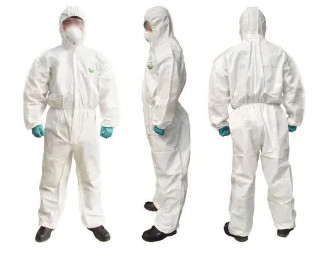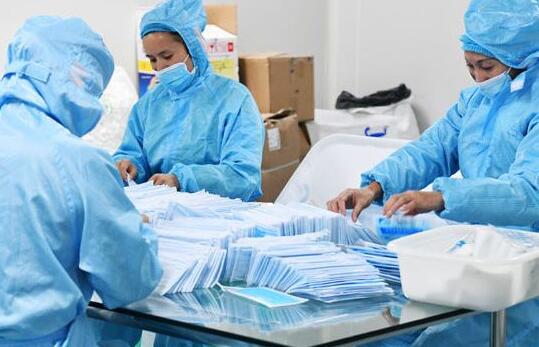
NewsInformation Center
Medical glove chemical protection performance tester test procedure
2022/12/16
Medical glove chemical protection performance tester test procedure
The movement of the test chemical through the barrier glove material in the form of osmosis, that is, in molecular form, due to the difference in concentration. process
include:
A chemical adsorbs to the material contact surface;
B The adsorbed molecules diffuse throughout the material;
C chemical desorbs from the reverse side of the material

Applicable standard
YY/T0616.5—2019 Medical Gloves Part 5, Test Method for Continuous Contact Resistance to Chemical Penetration
technical indicators
1. The test device is made of stainless steel with anti-rust and anti-corrosion functions;
2. The device consists of a test tank, a circulating water pump, a permeation test tank, a sealed box and corresponding pipelines;
3. Pressure control accuracy: +2% of the upper limit of the test pressure value, -1% of the lower limit;
4. Pressure measurement range: 0-500KPa; accuracy ±0.5%;
5. Peristaltic pump flow range: 0-10L/MIN
6. The shell is made of stainless steel and painted;
7. Control system: PLC
8. Operation interface: switch between Chinese and English
9. One water bath
10. Built-in gas storage tank 2L
11. Stainless steel permeation test pool, challenge room, collection room and other accessories
Closure test device
1. In the closure test, the minimum sensitivity of the system should be able to detect a permeation rate of 0.1 μg/(cm2 min) within a sampling period of 5 minutes.
NOTE: Closure assays are required to increase the sensitivity of the assay, and smaller chambers can be used to reduce the volume of collection medium. The sensitivity of the method can be increased by increasing the ratio of sample area to collection medium volume. However, these methods to improve sensitivity must be based on the premise of sufficient volume and mixing ratio, so as not to interfere with the permeation process.
2. The test chemical is a liquid used to evaluate the performance of medical glove materials. It can be one component (such as a pure liquid) or multiple components (such as a mixture).
NOTE: The test chemicals may be volatile (ie, the vapor pressure is greater than 1 mm Hg at 25 °C); or soluble in water, or soluble in other liquids that do not react with the glove material.
3. The collection medium should not interact with the glove material and must have sufficient permeable volume. Usually the closed device test chemical is an inorganic acid-base solution, and the collection medium is laboratory water in accordance with GB/T6682.
Note: To have sufficient infiltration volume, the infiltration of the collection medium during any test time should not exceed 20% of its saturation concentration. For liquid collection media, saturation is the maximum solubility or miscibility of the permeate in the liquid at the test temperature.
4. The penetration performance of medical glove materials against chemicals can be evaluated by measuring the breakthrough detection time, standard breakthrough time, permeation rate and cumulative permeation within a period of time of multiple parallel samples. These values are used to judge the chemical resistance of medical glove materials. A key indicator of product barrier effectiveness. The longer the breakthrough detection time and the standard breakthrough detection time, the smaller the cumulative penetration amount and penetration rate, and the better the barrier properties of the glove. Note: At present, most chemicals have only limited quantitative information on acceptable levels of skin exposure, so the data obtained by this test method cannot be used to infer safe exposure levels.

test pool
The test instrument consists of two chambers that contact the sample. Figure 1 shows an example of the test pool 1), which is usually made of glass with a diameter of about 25 mm. The length of the challenge chamber used to hold the test chemicals should be about The length of the collection chamber used to hold the collection medium should be equal to or less than 32mm.
Note 1: The test pool can also be processed by itself, the size
Note 2: When the test chemical is not compatible with glass (such as hydrofluoric acid), it is necessary to use a test cell of non-glass material (such as stainless steel). Chemicals used in the permeation test that may be considered for medical gloves
1. The ports of the challenge chamber and the collection chamber should be designed to be turned outward into a flange shape, so as to facilitate the clamping of the two chambers during the test.
2, A stop valve can be added to the inlet and outlet pipes of the collection chamber. The position of the inlet pipe and the outlet pipe nozzle should be suitable, and the inner diameter of the pipe, port, stop valve, etc. should be at least 2mm to prevent additional pressure difference in the system.
3. The two chambers of the test pool are equipped with a standard cone for adding and releasing test chemicals and collecting media. The collection chamber port can also be used to insert a stirrer into the chamber if desired.
Previous: Digital Elmendorf Tearing Tester for Medical Protective Clothing
N e x t : How to choose IULTCs Veslic leather friction tester?



